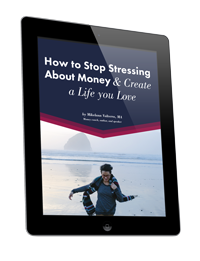I believe that in order to step into true abundance, you have to journey down the “threefold path to prosperity”. Below I write about these paths in more detail, with questions for you to ponder. In future blog posts, I will take each path deeper and deeper. Consider this the “threefold path overview”.
Emotional Money Path
The first path, emotional money, takes a deep look at why we do what we do with money. Many of us have deep seated beliefs about money—many of which are unconscious. We may secretly fear that to desire more money is greedy and we may mistrust wealthy people. This unvoiced “noble poverty” wreaks havoc on our ability to earn money.
How do you feel about the wealthy?
Some women feel great about money but secretly hope that somehow they will be “rescued” from the fate of having to earn it all themselves. Feelings of shame and undeservedness arise. These are all very common feelings, wrapped up in our childhoods and societies often confusing messages about money and work.
Do you hope something will rescue you so you don’t have to do this all alone?
Other women may feel less conflicted about money but have a hard time tapping into their personal drive and ambition, and feel ambivalent about money. The path of emotional money is where you dive into your feelings, give voice to your fears and name your beliefs. While these beliefs may no longer serve you, until they are brought to light, they will drive your behavior around money.
Practical Money Path
The second path is the practical money path. This is the path where you learn the skills around asking for more money, from how to set and raise your fees to how to comfortably negotiate for all your needs.
How do you feel about the money you charge? Do you need to charge your clients more money?
However, to come to the place of asking for more, it is helpful to vanquish the money fog that so many people live inside of. The money fog keeps us confused as to how much our lives really cost.
Do you know where your money goes and how much your business is costing you to run?
The practical money path also helps us figure out exactly how much money we need to earn to live a truly abundant life—a life that encompasses not only our needs and our desires but also security and freedom in the future as well as the ability to give money away.
Do you know how much money you need and want to make?
The Metaphysical Path
The final path, metaphysical money, is where you learn to consciously train your thoughts and change your feelings around money, to bring about the results you desire. There are many techniques to learn. This is the most advanced path and requires work on the other paths to be truly effective at this level.
For example, you must be aware of what you believe and be able to name your feelings before you can shift them (emotional money path) and you must know exactly what you desire (practical money) before you can focus on the result you want.
Do you know what it is you want to affirm for your life? Do you have an “abundance practice” that feeds your soul?
While a lot has been written about various “surface” aspects of the metaphysics of money, such as affirmations, this is a very deep path and goes straight to the heart of true prosperity and abundance. Some people meld this final path into their spiritual path.
Stay Tuned
I realize this can sound like a lot, but the truth is that our relationship to money is a complex relationship. This blog is devoted to these three paths, so you’ll see many posts that address how to embrace each path. It is different for everyone. I think we all naturally gravitate towards one path, which is great. But the question is, what do you need to work on that doesn’t feel “natural” to you? Read over the paths again. Can you embrace a part of each one?
